Two weeks ago, just ahead of autumn, we took a trip to Aomori. Aomori prefecture is the northernmost prefecture on the main island of Honshu, right across the strait to Hokkaido. Aomori city - a recent invention, a merger of two adjacent towns - is a fairly small community of about 300 000 people lying at the base of Mutsu bay.
The prefecture is most well known for its apple orchards, and Aomori apples sell at a premium here. The area is also famous for extensive archaeological findings from the
Jōmon period. There's apparently a lot of good downhill skiing in the mountains for the advanced skier, with a lot of steep off-pist areas. Aomori city itself used to be the gateway to Hokkaido, with a dense network of ferries between the two islands across the Tsugaru strait. The ferry services mostly disappeared when the rail tunnel was built between Hokkaido and Honshu, though, making the city a bit of a backwater.
We went to Aomori just overnight - to visit a friend of Ritsuko's, but also to do something a little different over a weekend. This kind of short trip is really, really effective. When you travel somewhere for a week or two you need to pace yourself or you'll run yourself ragged. But for a short weekend trip like this you can pack your schedule as tightly as you want; two days of hectic vacation is going to leave you invigorated, not worn out.
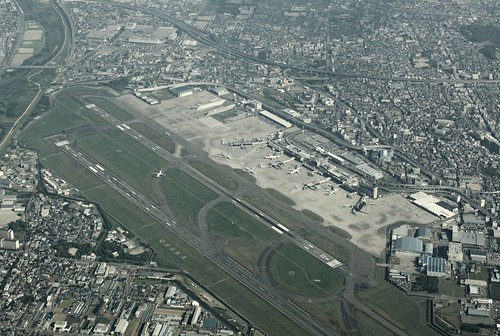
Itami airport. Used to be outside the city itself; now it's right in the middle of the northern part of it.
We left early Saturday morning from Osaka's old Itami airport. Governor Hashimoto wants to close it, by the way, and move all flights to Kansai airport out in the bay. He does have a point, as the city has grown around Itami and completely engulfed the airport by now, creating noise pollution and safety problems and making expansion impossible. That's bits of Osaka you see around the airport above, basically - offices, factories (down to the left), apartment buildings, a few schools, all nestled right up to the fence surrounding the airfield.
On the other hand, it
is a historical airfield in a country that is all too keen on tearing down old stuff before considering if it may have some cultural value. It's a charming little airport, and I hope it remains a least partially open and in use.
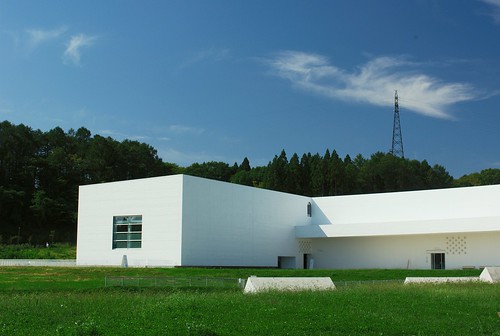
The Aomori Museum of Art. Good thing about buildings like this is, it's very easy to take a good picture. The bad thing is, it's very difficult to take a good picture that tenthousand other people haven't already taken.
Once we landed in Aomori we didn't even stop by the hotel; we went straight to the Aomori
Museum of Art. Another benefit of a short trip there: you have so little luggage you can just bring it all along as you go. The museum itself is in the typical modern concrete design for places like this: all smooth stone expanses and sharply delineated rectilinear shapes. I happen to really like it, as it gives the artwork inside space to shine.

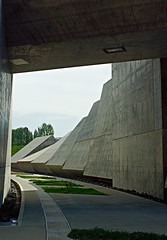
A couple of exterior shots. There was no photography allowed inside, unfortunately.
The museum has been criticized for having spent so much money on the building that they haven't been able to create a sufficient permanent collection. I don't know how well-founded that criticism is, but that's not how it felt to me. Most of the permanent space contains works by artists with a connection to the area - exactly what a prefectural museum should focus on, I think. They do have a room near the entrance with
three enormous Chagall paintings, backdrops for an opera, and while the paintings are apparently not counted among his foremost works, the presentation and the sheer size makes a pretty powerful impression on you.
The temporary exhibition was
"Box-art of plastic models and Japan’s postwar culture". Far more fascinating than I thought it would be. I was not alone in finding it interesting either; there were more nerds visiting that exhibition than the museum have likely seen since it opened.
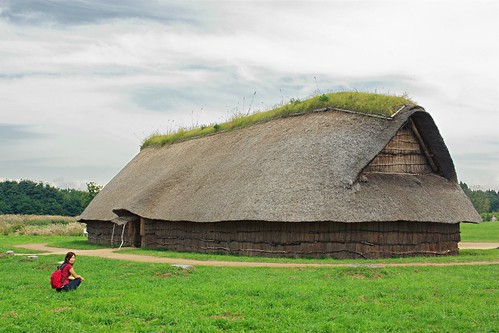
Jōmon period longhouse, observed by not-so-Jōmon period woman.
Just a short walk from the museum you find
Sannai-Maruyama, a large archaeological site with traces from the
Jōmon period. 縄文 ("Jōmon") means something like "rope pattern" and refers to the practice of decorating pottery with sometimes intricate rope pattern impressions. The field was found when a new sports stadium was being built; the stadium plans were quickly abandoned and the field excavated (excavations seems to continue today). There's a number of reconstructed buildings as well as climate-controlled domes with the real excavations, and a small museum housing found artifacts. Very pleasant place to walk around even if you would have little interest in the archaeology. I have a few more pictures of the site
here.
From the site we took the bus into Aomori city proper. We checked in at the hotel, then left for the third museum of the day: the
Munakata Shiko Memorial Museum of Art.
Munakata Shiko was a wood block print artist from Aomori, and retained his connections to the area throughout his life. He gave one set of prints of his masterpiece "Ten Great Disciples of Buddha" to the museum, with specific instructions on the order they should hang. There's a not very good image of them
here - why is it so hard to find decent examples of artworks online, by the way?
Munakata's woodblock prints are spectacular in real life to be sure, but we went to the museum because Ritsuko's friend is working there. After a tour - the museum is dedicated to one artist so it's not very big - we left for dinner at a local fish restaurant. The food was excellent and with our host being very talkative and entertaining it made for a long, pleasant evening. After dinner we took a walk along the waterfront before returning to the hotel.
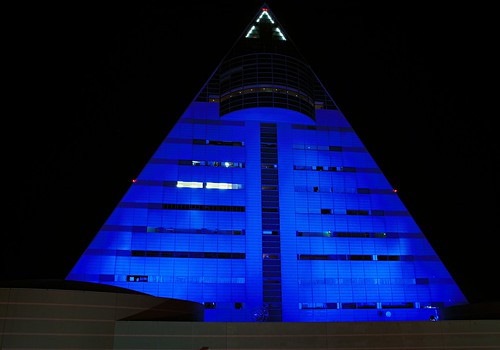
The Aspam pyramid is a tourist information center and local speciality store in the harbour. Well, it works; I doubt there's a tourist that doesn't visit and take a picture of the place. And if the country is dead set to waste its money on unnecessary construction I certainly prefer something fun like this over yet another elevated motorway.
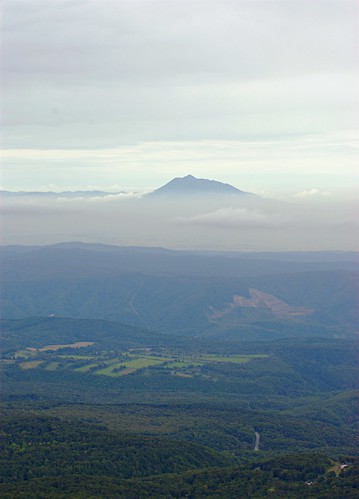 Hakkoda mountains
Hakkoda mountainsThe next morning saw us at an early breakfast. A travel tip I swear by: the local breakfast style is almost always better made and better tasting than the bland international "continental breakfast" stuff. The same goes for dinner as well of course.
From Aomori city there is a regular bus line out to the
Hakkōda mountains near the city. Northern Honshu gets lots of snow in the winter so there's plenty of cross-country and downhill off-pist skiing in the Hakkoda mountains, and in the summer it's a pretty popular hiking area. The bus trip takes an hour or thereabouts, in a comfortable bus, on winding mountain roads with sometimes spectacular scenery. We got off at mount Tamoyachi where there's a ropeway up to the top of the mountain. The ropeway runs up the densely forested mountain side and is famous for some spectacular fall color views as the foliage turns yellow and red all along the whole mountain range.
We were a little early for the changing of leaves, with but a few trees starting to turn color. At the top there's a couple of walking trails for those who don't want to go across country, and the view is very good when the weather cooperates. Unfortunately, it didn't in our case. It was cool and dry, but also quite overcast and somewhat hazy, making the far vistas disappear into the mist. Still well worth the trip though. More pictures
here.
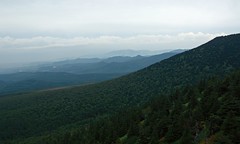
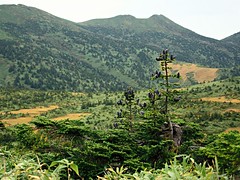
A couple of Hakkoda views. They are really much better when large, so click through.
Back in Aomori city we had lunch - Indian food; inexpensive and quite good - after which we took a walk through town for some sightseeing and shopping (mostly local foods like apples, dried squid, ramen and sake). There's been settlements in the area for a very long time of course, but Aomori city owes its existence to its role as a communications hub. It's located at the base of large, protected bay so it's a good transit point between sea and land transport, especially between the main island of Honshu and the resource-rich and sparsely populated northern island of Hokkaido.
The ferry lines between the two islands were very heavily used, so in the 1970's a train tunnel between the islands was built and opened in the early 1980's. With the tunnel taking a lot of the cargo traffic and cheap air transport taking most passengers the ferry lines largely disappeared. There are still ferries going between the islands but not in anything resembling the volumes of earlier times. As a result, Aomori city has to some extent become a city looking for a reason to exist.

One of the ferries from the now defunct JR ferry line is laid up at the original pier in the harbour as a museum.
Ferries and waterways have always held a lot of symbolic meaning, of course, so it's only natural that they would lodge in public consciousness and popular culture in a big way. There's several songs, movies and so on about the Tsugaru strait.
One song, however, stands out: "Tsugaru Kaikyou Fuyu Geshiki" - "Tsugaru strait winter view" (hear it on Youtube - with one of the original ferries as backdrop -
here). This enka - the song is about how the singer is boarding the ferry by herself, leaving her love behind - was an astounding hit, and you still hear it often, in original or as a cover. It's one of those songs that everybody knows and lots of people do covers on, and it's a popular karaoke song as well. Right next to the museum ferry is a large stone monument to the song - and better yet, the monument has motion sensors so it starts blasting out the song whenever anyone comes near. And as it turns out, quite a lot of people do. Both the ferry line and this song are known and loved, so many people that visit Aomori take the short walk out to the harbour to see the ferry and the monument.

Monument to Tsugaru Kaikyou Fuyu Geshiki, in front of the Hakkoda Maru museum ship. Yes, the song was playing constantly as we took these pictures.
This was a short, fun trip, and as this (over)long post shows, as packed with impressions as a longer vacation would have been. We really have to do this kind of vacation more often. More pictures from Aomori
in this set.












